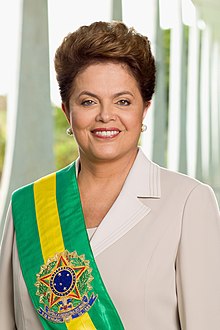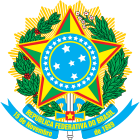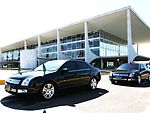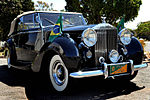| Revision as of 14:05, 30 May 2013 editVinícius18 (talk | contribs)430 edits →Presidents by age at accession← Previous edit | Revision as of 11:43, 2 June 2013 edit undoVinícius18 (talk | contribs)430 editsNo edit summaryNext edit → | ||
| Line 2: | Line 2: | ||
| {{Infobox Political post | {{Infobox Political post | ||
| |post = President | |post = President | ||
| |body = the<br/> |
|body = the<br/>Federative Republic of Brazil | ||
| |insignia = Presidential Standard of Brazil.svg | |insignia = Presidential Standard of Brazil.svg | ||
| |insigniacaption = ] | |insigniacaption = ] | ||
| Line 18: | Line 18: | ||
| {{Politics of Brazil}} | {{Politics of Brazil}} | ||
| The '''President of Brazil''', officially the '''President of the |
The '''President of Brazil''', officially the '''President of the Federative Republic of Brazil''' ({{lang-pt|Presidente da República Federativa do Brasil}}), or simply the ''President of the Republic'', is both the ] and ] of the ]. The president leads the ] of the ] and is the ] of the ]. The ] was established in 1889, upon the proclamation of the republic in a military coup d'état against Emperor ]. Since then, Brazil had six ], two dictatorships and three democratic periods. During these democratic periods, voting has always been ]. The ], along with several ], establishes the requirements, powers, and responsibilities of the president, as well as the term of office and method of election.<ref>Constitution of the Federative Republic of Brazil, art. 15 and Chapter II</ref> | ||
| ==Election process== | ==Election process== | ||
Revision as of 11:43, 2 June 2013
| President of the Federative Republic of Brazil | |
|---|---|
 Presidential Standard of Brazil Presidential Standard of Brazil | |
 Incumbent IncumbentDilma Rousseff since January 1, 2011 | |
| Style | Madam President (informal) Most Excellent Madam President of the Republic (formal) Her Excellency (alternative formal, diplomatic) |
| Residence | Palácio da Alvorada |
| Term length | Four years, renewable once consecutively |
| Inaugural holder | Deodoro da Fonseca February 26, 1891 |
| Formation | Proclamation of the Republic November 15, 1889 |
| Salary | $320,678 annually |
| Website | planalto.gov.br |
| This article is part of a series on the |
| Politics of Brazil |
|---|
 |
Executive
|
| Legislative |
Judiciary
|
| Law |
| Administrative divisions |
|
Elections
Recent elections |
Foreign relations
|
| Related topics |
The President of Brazil, officially the President of the Federative Republic of Brazil (Template:Lang-pt), or simply the President of the Republic, is both the head of state and head of government of the Federative Republic of Brazil. The president leads the executive branch of the federal government and is the commander-in-chief of the Brazilian Armed Forces. The presidential system was established in 1889, upon the proclamation of the republic in a military coup d'état against Emperor Dom Pedro II. Since then, Brazil had six constitutions, two dictatorships and three democratic periods. During these democratic periods, voting has always been compulsory. The Brazilian Constitution of 1988, along with several constitutional amendments, establishes the requirements, powers, and responsibilities of the president, as well as the term of office and method of election.
Election process
Eligibility
According to the 1988 Constitution, the president must be a native-born citizen of Brazil, be at least 35 years of age, be a resident in Brazil, be an elector, have all the electoral rights, and be inscribed in a political party (write-in candidates are forbidden).
Term of office
The presidential term of office is currently four years. The current length of the presidential term of office was adopted in 1994 by means of a constitutional amendment (review constitutional amendment number 5). From 1889 to 1937 and again from 1945 to 1997, the president was barred from immediate reelection. In 1997, however, the 16th amendment allowed a president to be elected any number of times, but not more than twice in a row. A former President, even one who already served two consecutive terms, can become a candidate for the Presidency again, provided that he or she is not a candidate for the four-year period immediately succeeding his second term.
A vice-president or another officer in the line of succession who succeeds to the Presidency or who serves, albeit briefly, as Acting President during a certain presidential term (which all Brazilian Vice-Presidents do, given the current practice of the Vice-President becoming Acting President during the President's travels abroad) can subsequently be elected to the Presidency once only and the consecutive term limit already applies.
Although re-election to the same office is allowed once consecutively, Brazilian Presidents cannot run for a different office while serving in the Presidency. In order to be eligible as a candidate for a different office, per the Federal Constitution, a President of Brazil would need to resign his office six months before the date of the elections. The same rule applies to the Governors of the States and to the Mayors of the municipalities.
Duties and powers
As a republic with a presidential Executive, Brazil grants significant powers to the President. He or she effectively controls the Executive branch, represents the country abroad, and appoints the Cabinet and, with the approval of the Senate, the judges for the Supreme Federal Tribunal. The president is also the Commander-in-Chief of the armed forces.
Presidents in Brazil also have significant lawmaking powers, exercised either by proposing laws to the National Congress, or else by using Medidas Provisórias (Provisional Measures), an instrument with the force of law that the President can enact in cases of urgency and necessity, except to make changes to some areas of Law (provisional measures cannot be used to change criminal law, electoral law, tax law, among other cases). A Provisional Measure comes into effect immediately, before Congress votes on it, and remains in force for up to 60 days unless Congress votes to rescind it. This 60 day period can be extended once, up to a maximum of 120 days. If Congress, on the other hand, votes to approve the provisional measure, it becomes an actual law, with changes decided by the Legislative Branch. The provisional measure expires at the end of the 60 day period (or 120 day, in case of extension), or sooner, if rejected by one of the Houses of Congress.
Article 84 of the current Constitution, determines that the President has the power to:
- appoint and dismiss the Ministers of State;
- exercise, with the assistance of the Ministers of State, the higher management of the federal administration;
- start the legislative procedure, in the manner and in the cases set forth in the Constitution;
- sanction, promulgate and order the publication of laws, as well as to issue decrees and regulations for the true enforcement thereof;
- veto bills, wholly or in part;
- provide, by means of decree, on organization and structure of federal administration, in the cases where there is neither increase of expenses nor creation or extinction of public agencies; and extinction of offices or positions, when vacant;
- maintain relations with foreign States and to accredit their diplomatic representatives;
- conclude international treaties, conventions and acts, subject to the ratification of the National Congress;
- decree the state of defense and the state of siege, in accordance with the constitional procedures that shall precede and authorize those emergency decrees;
- decree and enforce federal intervention, in accordance with the constitutional procedures that shall precede and authorize such exceptional action;
- upon the opening of the legislative session, send a government message and plan to the National Congress, describing the state of the nation and requesting the actions he deems necessary;
- grant pardons and reduce sentences, after hearing the entities instituted by law, if necessary;
- exercise the supreme command of the Armed Forces, appoint the commanders of Navy, Army and Air Force, promote general officers and to appoint them to the offices held exclusively by them;
- appoint, after approval by the Senate, the Justices of the Supreme Federal Court and those of the superior courts, the Governors of the territories, the Attorney-General of the Republic, the President and the Directors of the Central Bank and other civil servants, when established by law;
- appoint, with due regard for the provisions of article 73, the Justices of the Federal Court of Accounts;
- appoint judges in the events established by this Constitution and the Advocate-General of the Union;
- appoint members of the Council of the Republic, in accordance with article 89, VII;
- summon and preside over the Council of the Republic and the National Defense Council;
- declare war, in the event of foreign aggression, authorized by the National Congress or confirmed by it, whenever it occurs between legislative sessions and, under the same conditions, to decree full or partial national mobilization;
- make peace, authorized or confirmed by the National Congress;
- award decorations and honorary distinctions;
- permit, in the cases set forth by supplementary law, foreign forces to pass through the national territory, or to remain temporarily therein;
- submit to the National Congress the pluriannual plan, the bill of budgetary directives and the budget proposals set forth in this Constitution;
- render, each year, accounts to the National Congress concerning the previous fiscal year, within sixty days of the opening of the legislative session;
- fill and abolish federal government positions, as set forth by law;
- issue provisional measures, with force of law, according to article 62;
- perform other duties set forth in the Constitution.
Compensation and privileges of office
| Presidential styles of Dilma Rousseff | |
|---|---|
 | |
| Reference style | Sua Excelência a Presidente da República or A Excelentíssima Senhora Presidente da República "Her Excellency the President of the Republic" or "The Most Excellent Madam President of the Republic" |
| Spoken style | Vossa Excelência or Excelentíssima Senhora Presidente da República "Your Excellency" or "Most Excellent Madam President of the Republic" |
| Alternative style | Senhora Presidente "Madam President" |
The president earns a R$26.723,13 monthly salary, along with an undisclosed expense account to cover travel, goods and services while in office. The most recent raise in salary was approved by Congress in December 2010 and went into effect in February 2011. Given that in Brazil all private and public sector employees and civil servants receive an additional compensation equivalent to one monthly salary after a year of work (this compensation is known as the thirtheenth salary), the President receives thirteen payments of R$ 26.723,13 per year, resulting in an annual salary of R$ 347.400,69.
The Palácio do Planalto in Brasília is the official workplace of the president and the Palácio da Alvorada his/her official residence; he/she is entitled to use its staff and facilities. The Residência Oficial do Torto, popularly known as Granja do Torto, is a ranch located on the outskirts of the capital and is used as a country retreat by the president. The Palácio Rio Negro in Petrópolis, Rio de Janeiro, is a summer retreat of the president, although used rarely.
In addition, the Presidency of the Republic also maintains the Jaburu Palace in Brasília for use by the Vice-President of the Republic as his official residence.
In the 2000s (decade), the Federal Government decided to establish Regional Offices of the Presidency of the Republic in certain key Brazilian cities. Those regional offices are not presidential residences, but they are fully staffed offices ready to receive the President and his Ministers at any time, and they function as a presidential workplace when the President is in those cities. The first Regional Office of the Presidency was established in the city of São Paulo, and is located at the Banco do Brasil building at the Paulista Avenue; the building also houses Banco do Brasil's regional headquarters in São Paulo. The Presidency of the Republic also maintains regional offices in Porto Alegre and in Belo Horizonte.
For ground travel, the president uses the presidential state car, which is an armored version of the 2011 Ford Fusion Hybrid built on a Ford CD3 platform. A 1952 Rolls Royce Silver Wraith is used by the president on ceremonial occasions, such as Independence Day commemorations, state visits and the inauguration of the President-elect. A modified version of the Airbus A319, Air Force designation VC-1A, is used to transport the president on all medium and long-range international flights. Two modified Embraer 190 jets, Air Force designation VC-2, are used for short and medium range presidential travel. When the president is on board, the aircraft receive the call sign "Brazilian Air Force One". Two modified military versions of the Eurocopter Super Puma, Air Force designation VH-34, are currently used as the main presidential helicopters.
- Presidential Amenities
-
 Palácio do Planalto
Palácio do Planalto
-
 The President's office
The President's office
-
 Palácio da Alvorada
Palácio da Alvorada
- Residência Oficial do Torto Residência Oficial do Torto
-
Palácio Rio Negro
-
 Presidential state car
Presidential state car
-
 Ceremonial state car
Ceremonial state car
-
 Main presidential aircraft (VC-1A)
Main presidential aircraft (VC-1A)
-
 Secondary presidential aircraft (VC-2)
Secondary presidential aircraft (VC-2)
-
 Presidential helicopter (VH-34)
Presidential helicopter (VH-34)
Post-presidency
The following privileges are guaranteed to former Presidents by law:
- Permanent security protection (by the Presidential Guard – Batalhão da Guarda Presidencial)
- The use of two official vehicles (for life)
- Repository funding for a Presidential library
- Lifelong monthly pension for widows and unmarried daughters of ex-presidents;
- Pension for sons of ex-presidents until they come of age, should a president or former president die leaving an underage son.
- Living former presidents
-
José Sarney, served 1985–1990
José Sarney,
served 1985–1990 -
Fernando Collor de Mello, served 1990–1992
Fernando Collor de Mello,
served 1990–1992 -
 Fernando Henrique Cardoso,
Fernando Henrique Cardoso,
served 1995–2003 -
 Luiz Inácio Lula da Silva,
Luiz Inácio Lula da Silva,
served 2003–2010
Office-holders
Main article: List of Presidents of BrazilAll Presidents of Brazil bore the title President of the Republic. That title has been used by all the Constitutions of Brazil since the proclamation of the Republic to refer to the head of the Executive Branch.
However, from the proclamation of the Republic in 1889 until 1967 the country was officially styled Republic of the United States of Brazil, and thus the full title of the Presidents from Deodoro da Fonseca to Humberto Castello Branco was President of the Republic of the United States of Brazil. On March 15, 1967, the country's official name was changed to Federative Republic of Brazil. On that same date, Arthur da Costa e Silva was sworn in as President. Since Costa e Silva, therefore, all Presidents of Brazil bear the full title of President of the Federative Republic of Brazil.
-

1st Deodoro da Fonseca 1889–1891 -

2nd Floriano Peixoto 1891–1894 -

3rd Prudente de Morais 1894–1898 -

4th Campos Sales 1898–1902 -

5th Rodrigues Alves 1902–1906 -

6th Afonso Pena 1906–1909 -

7th Nilo Peçanha 1909–1910 -
8thHermes da Fonseca1910–1914
8th Hermes da Fonseca 1910–1914 -

9th Venceslau Brás 1914–1918 -

· Rodrigues Alves Did not take office -
10thDelfim Moreira1918–1919
10th Delfim Moreira 1918–1919 -

11th Epitácio Pessoa 1919–1922 -

12th Artur Bernardes 1922–1926 -

13th Washington Luís 1926–1930 -

· Júlio Prestes Did not take office -

Interim government Military Junta 1930 -

14th Getúlio Vargas 1930–1945 -

15th José Linhares 1945–1946 -

16th Eurico Gaspar Dutra 1946–1951 -

17th Getúlio Vargas 1951–1954 -

18th Café Filho 1954–1955 -

19th Carlos Luz 1955 -

20th Nereu Ramos 1955–1956 -

21st Juscelino Kubitschek 1956–1961 -

22nd Jânio Quadros 1961 -

23rd Ranieri Mazzilli 1961 -

24th João Goulart 1961–1964 -

25th Ranieri Mazzilli 1964 -

26th Castelo Branco 1964–1967 -

27th Artur da Costa e Silva 1967–1969 -

· Military Junta 1969 -

28th Emílio Garrastazu Médici 1969–1974 -
29thErnesto Geisel1974–1979
29th Ernesto Geisel 1974–1979 -

30th João Figueiredo 1979–1985 -
·Tancredo NevesDid not take office
· Tancredo Neves Did not take office -
31stJosé Sarney1985–1990
31st José Sarney 1985–1990 -
32thFernando Collor1989–1992
32th Fernando Collor 1989–1992 -
33rdItamar Franco1992–1994
33rd Itamar Franco 1992–1994 -

34th Fernando Henrique Cardoso 1995–2002 -

35th Luiz Inácio Lula da Silva 2003–2010 -

36th Dilma Rousseff 2011–
Presidents by home state
Minas Gerais: 9 (Afonso Pena, Venceslau Brás, Delfim Moreira, Artur Bernardes, Carlos Luz, Juscelino Kubitschek, Tancredo Neves, Itamar Franco, Dilma Rousseff)
Rio Grande do Sul: 6 (Hermes da Fonseca, Getúlio Vargas, João Goulart, Costa e Silva, Emílio Garrastazu Médici, Ernesto Geisel)
São Paulo: 5 (Prudente de Morais, Campos Sales, Rodrigues Alves, Júlio Prestes, Ranieri Mazzilli)
Rio de Janeiro: 5 (Nilo Peçanha, João Figueiredo, Washington Luís, Fernando Collor de Mello, Fernando Henrique Cardoso)
Alagoas: 2 (Deodoro da Fonseca, Floriano Peixoto,)
Ceará: 2 (José Linhares, Castelo Branco)
Mato Grosso: 2 (Eurico Gaspar Dutra, Jânio Quadros)
Maranhão: 1 (José Sarney)
Paraíba: 1 (Epitácio Pessoa)
Rio Grande do Norte: 1 (Café Filho)
Santa Catarina: 1 (Nereu Ramos)
Pernambuco: 1 (Luiz Inácio Lula da Silva)
Presidents by age at accession
Deodoro da Fonseca: 62, Floriano Peixoto: 52, Prudente de Morais: 53, Campos Sales: 57, Rodrigues Alves: 54 (first time), 70 (elected second time), Afonso Pena: 58, Nilo Peçanha: 41, Hermes da Fonseca: 55, Venceslau Brás: 46, Delfim Moreira: 49, Epitácio Pessoa: 54, Artur Bernardes: 47, Washington Luís: 57, Getulio Vargas: 48 (first time), 68 (second time) – oldest President, José Linhares: 59, Eurico Gaspar Dutra: 62, Café Filho: 44, Carlos Luz: 61, Nereu Ramos: 67, Juscelino Kubitschek: 53, Jânio Quadros: 44, Pascoal Ranieri Mazzilli: 51 (first time), 52 (second time), João Goulart: 42, Humberto de Alencar Castelo Branco: 66, Artur da Costa e Silva: 67, Emílio Garrastazu Médici: 63, Ernesto Geisel: 66, João Figueiredo: 61, Tancredo Neves: elected at 75 – oldest President elected, José Sarney: 54, Fernando Collor de Mello: 40 – youngest President, Itamar Franco: 62, Fernando Henrique Cardoso: 64, Luiz Inácio Lula da Silva: 57, Dilma Rousseff: 63
Latest election
Main article: Brazilian presidential election, 2010Template:Brazilian presidential election, 2010
See also
- List of presidential trips made by Dilma Rousseff
- List of Presidents of Brazil
- Brazilian presidential inauguration
- Brazilian presidential election, 2010
- Politics of Brazil
- Cabinet of Brazil
- Vice-President of Brazil
- FAB Uno
References
- ^ Câmara aprova aumento nos salários do presidente da República, ministros e deputados ("Chamber of Deputies raises the salary of the President of the Republic, ministers and deputies") O Globo. Retrieved on 2011-05-27. Template:Pt.
- Constitution of the Federative Republic of Brazil, art. 15 and Chapter II
- Constitution of the Federative Republic of Brazil, art. 62 as amended by Constitutional Amendment n. 32
- Ajuste ainda não chegou aos gastos sigilosos ("Cuts have yet to be made to undisclosed expenses") Ministério do Planejamento. Retrieved on 2011-05-27. Template:Pt.
- Palácio do Planalto Presidência da República. Retrieved on 2011-05-27. Template:Pt.
- Palácio da Alvorada Presidência da República. Retrieved on 2011-05-27. Template:Pt.
- Granja do Torto Presidência da República. Retrieved on 2011-05-27. Template:Pt.
- Rio Negro Palace Prefeitura de Petrópolis. Retrieved on 2011-05-27.
- Brazilian President receives Ford Fusion Hybrid at São Paulo Auto Show Ford. Retrieved on 2010-11-28.
- Recibe Da Silva Ford Fusion Híbrido en Brasil Terra. Retrieved on 2010-11-28. Template:Es.
- Rolls-Royce presidencial é um dos destaques do desfile de 7 de setembro ("Presidential Rolls Royce is one of the highlights of the Independence Day parade") Presidência da República. Retrieved on 2011-05-27. Template:Pt.
- Infográfico especial sobre o avião presidencial ("Special infographic of the presidential airplane") Presidência da República. Retrieved on 2011-05-27. Template:Pt.
- ^ FAB 001 – O Avião Presidencial DefesaBR. Retrieved on 2011-05-27. Template:Pt.
- Presidência da República nas asas da Embraer ("The Presidency on the wings of Embraer") Presidência da República. Retrieved on 2011-05-27. Template:Pt.
- Helicóptero Presidencial Brasileiro (VH-34 Super Puma VIP) ("Brazilian Presidential Helicopter (VH-34 Super Puma VIP)" Hangar20. Retrieved on 2011-05-27. Template:Pt.
- "Galeria dos Presidentes — informações históricas" (in Portuguese). Presidência da República. Retrieved April 25, 2007.
- "Federal Constitution of 1988" (in Portuguese). Presidência da República. Retrieved April 25, 2007.
- "New Air Force One for President Lula". MercoPress. Retrieved July 6, 2006.
- "Centro de Informação de Acervos dos Presidentes da República" (in Portuguese). Arquivo Nacional. Archived from the original on April 3, 2007. Retrieved April 25, 2007.
External links
- Official website of the Presidency of the Republic Template:Pt icon
- Official website of the National Archives of Brazil, featuring detailed information on every presidential administration Template:Pt icon
- Museum of the Republic Template:Pt icon
- Presidents of Brazil 1889–2006
| Brazil articles | |||||||
|---|---|---|---|---|---|---|---|
| History | |||||||
| Geography | |||||||
| Politics | |||||||
| Economy |
| ||||||
| Society |
| ||||||
| Presidents of South America | |
|---|---|
| Sovereign states | |
| Dependencies and other territories | |
| Heads of state of South American countries | |
|---|---|